Those unfamiliar with the sport of greyhound racing could easily be forgiven for thinking that any given race is much the same as another. All races do after all take place on a sand surface on an outdoor oval track and – at least in the UK and Ireland – all feature six dogs wearing uniform jackets: red for number 1, blue for 2, white for 3, black for 4, orange for 5 and black and white stripes for 6. All told, it is a sport that is certainly more uniform than the wide array of courses and kaleidoscopic racing silks witnessed in horse racing for example.
Assessing Ability
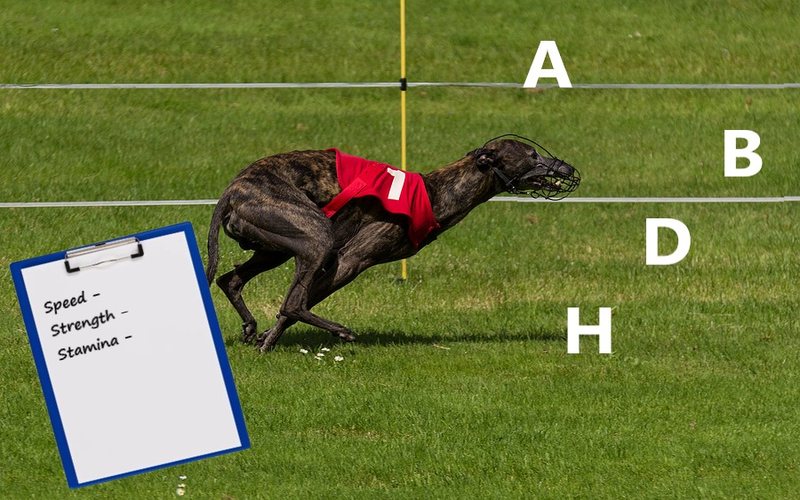
Much like in the “sport of kings” however – which features horses of a wide range of abilities – all greyhounds are not created equally, be that in terms of overall talent, or the type of race in which they may perform to best effect.
As such, what is needed is a grading system aimed at grouping dogs of similar abilities together, in order to create competitive, exciting action. Falling under the overall umbrella of the sport’s governing body, the Greyhound Board of Great Britain (GBGB), each of the UK’s 20 officially registered tracks employ a “grader” to assess the ability of the dogs who perform at that track. One point to note here is that unlike in horse racing, where runners regularly compete at different courses from one race to another, in greyhound racing all dogs will be attached to a specific track, doing the vast majority of their racing at that venue unless travelling for an Open Race (more on which later).
So how does it all work? Essentially greyhound grades consist of two elements: a letter which refers to the type of race, and a number which reflects the ability of the dogs competing. When glancing through the card of a greyhound meeting, alongside the race times punters will find an array of these letter/number combinations, for example A1, A4, B2, S5 and so on. Here we take a look at exactly what this annotation signifies, beginning with the letters.
Types of Race: It’s As Easy as A, B… D… H
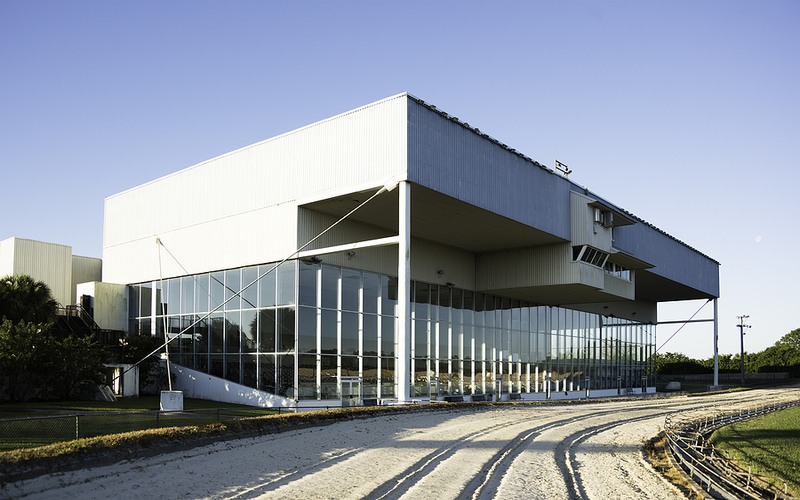
Much like horses, the greyhound population consists of a range of different types of runners. Some dogs are all about speed and seen to best effect over shorter distances, whilst other stamina-laden performers may be too slow for a standard race, but really come into their own over longer distances. As such it makes sense that the greyhound authorities should strive to create a programme of races designed to cater to all abilities and distance preferences.
Whilst not quite so varied as in horse racing, which sees runners lock horns over distances ranging from five furlongs all the way up to four miles or more, the greyhound programme does feature its own sprint, middle distance, and staying divisions, together with handicaps, and races restricted by age or experience. As mentioned, this type of race is denoted by a letter, with the full list of race types running as follows.
| Letter Code | Race Type | Description |
|---|---|---|
| A | Middle Distance | 380m to 500m: By far the most common race type. Also referred to as Standard. |
| B | Middle Distance | 380m to 500m but where the track’s standard distance has been adjusted slightly. |
| D | Sprint | 200m to 350m. Usually taking in only two of a track’s four bends. |
| H | Hurdle | A race featuring low obstacles to be jumped. |
| HP/Hcp | Handicap | Starting stalls are staggered to give the slower dogs a head start. |
| S | Stayers | 600m to 700m, for those runners which require more distance than a standard race. |
| M | Marathon | Stamina-sapping races over 800m to 1000m. |
| N | Novice | For previously unraced or very inexperienced dogs. |
| P | Puppy | Restricted to dogs aged between 15 and 24 months. |
| OR | Open Race | Highest Class events featuring dogs from a number of different tracks. |
Whilst most of the categories are fairly self-explanatory, those of B, HP and OR perhaps need a little clarification.
Let us first look at the example of Crayford dog track in order to illustrate the category B classification. Crayford has a Standard race distance of 380m – all contests held over this distance will therefore fall into the “A” category. The track does however also stage occasional races over a trip of 430m – a distance which (like 380m) also falls into the Middle-Distance category. Such events at Crayford, or any other track, are labelled as “B” in order to quickly identify that the contest – whilst being a middle-distance race – will not be held over the track’s “Standard” distance.
Turning next to handicap events. Unlike handicap races in horse racing, where the runners are required to carry different amounts of weight depending upon their ability, in greyhound racing the dogs are handicapped by distance i.e., the slower runners are given a head start over their quicker rivals. This method is executed by staggering the starting stalls according to the recent race times posted by the runners; 0.08s equating to one metre in distance. In a handicap race, the traps will be staggered backwards from trap 1 outwards, with the quickest dog starting in trap 6 and said to be running off “scratch”.
Open Races refer to races at the top end of the sport such as the Greyhound Derby or Greyhound St Leger. Designed to crown champions, these events see a host track welcome greyhounds from all around the UK and Ireland in order to take part.
Assessing Ability: Race Grades
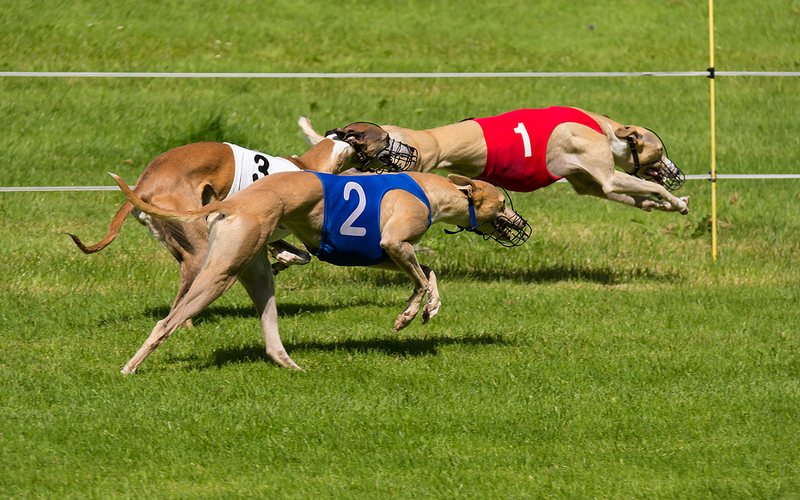
It is up to a greyhound’s trainer to determine the distance over which each of their runners should be competing. Having selected this distance each dog must then complete a series of qualifying trials over the elected distance in order to determine their level of ability. This usually consists of two separate trials at the track, although the greyhound manager may request additional outings should they consider more evidence is needed in order to determine the dog’s running style and overall ability.
The times posted by each dog in their trial will then be compared to the standard times for each grade at the track, with the dog being assigned to the grade in which their time sits. Having been allocated a grade, the runner is described as having been “graded on” and becomes eligible to race.
Each race type detailed above features its own grading divisions, with Grade 1 representing the quickest dogs, Grade 2 the next fastest, and so on. Courtesy of having the largest pool of greyhounds, the “A” category begins at A1 for the most talented runners and runs all the way down to A11 for the slowest dogs. This may seem like a lot of individual grades but does help in framing races, and results in less overall variation between the runners in each grade. The sprinting and staying divisions in contrast have a smaller pool of dogs, which is reflected in fewer grades – most tracks operating D1 to D6 and S1 to S6 classifications.
As in the majority of sports, the higher the class of the action, the higher the associated prize money. Whilst the exact values vary from track to track, the following table taken from a race night at Sunderland dog track serves to illustrate the overall pattern and levels of difference between grades.
| Grade of Race | Total Prize Money |
|---|---|
| A1 | £450 |
| A2 | £410 |
| A3 | £400 |
| A4 | £390 |
| A5 | £385 |
| A6 | £380 |
| A7 | £350 |
| A8 | £345 |
| D3 | £300 |
Open Races: Elite Level Competition
 The best of the Grade 1 performers will ultimately gravitate to Open Races (OR) which lie in their own bubble above the standard grading ladder.
The best of the Grade 1 performers will ultimately gravitate to Open Races (OR) which lie in their own bubble above the standard grading ladder.
In parallel with the Group and Graded races of horse racing, the open race category is further subdivided into three sections: OR1, OR2 and OR3, which together make up what is referred to as the Major Open Race category.
And lying just below this – being comparable to Listed Class horse racing contests – is the Minor Open Race grouping.
Representing the most prestigious contests in the sport, Open Race prize money almost always beats that of standard graded events, and sometimes spectacularly so, as illustrated in the table below.
| Grade | Prize Money Guide |
|---|---|
| OR1 | For example: Puppy Derby £25,000, English Derby £175,000 |
| OR2 | Up to £6,500 |
| OR3 | Minimum of £800 up to £1800 |
| Minor Open | Minimum of £100 to the winner |
Grade Comparison
Determining one grade from another can be a difficult task with the naked eye, with only around 4mph separating the very quickest from the very slowest runners. That may not sound like a lot, but it is enough to make a difference of around 3.75 to 5 metres over the course of a standard race distance. As a general guide, the following table illustrates the top speeds achieved by the runners across the middle-distance race grades.
| Grades | Top Speed |
|---|---|
| A1-A3 | 38-39mph |
| A4-A6 | 37-38mph |
| A7-A11 | 35-37mph |
Climbing the Ladder
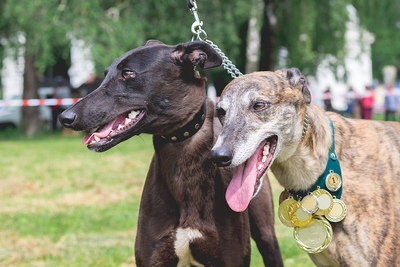 And of course, having been assigned a specific grade, a dog is not confined to that rating indefinitely. Just as in horse racing, greyhounds can both improve or regress over time, moving up and down the grading ladder as their performances dictate.
And of course, having been assigned a specific grade, a dog is not confined to that rating indefinitely. Just as in horse racing, greyhounds can both improve or regress over time, moving up and down the grading ladder as their performances dictate.
A string of wins in a specific grade is likely to result in the dog being upgraded, with a sequence of poor outings seeing the dog downgraded. And sometimes these ascents and descents through the ranks can be fairly rapid – a dog by the name of Black Edition for example progressed from A10 to A1 courtesy of 10 rapid-fire wins during 2021.
Generally speaking, most runners will begin life competing in the A7 to A11 grades, advancing upwards as they approach their peak racing age of 30 to 36 months (slightly younger for sprinters, slightly older for stayers), before then descending again as they enter the veteran stage of their career.
Race Seeding
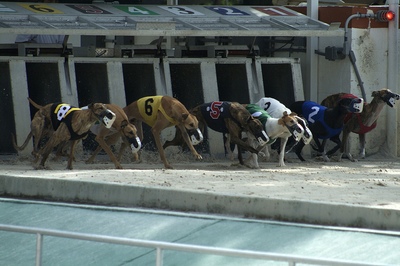 One final thing to be aware of in the world of greyhound racing is the manner in which the starting traps are assigned. Unlike in horse racing, where the starting stalls of each runner are determined by draw, in greyhound racing each dog will be specifically assigned a box designed to align with their particular running style.
One final thing to be aware of in the world of greyhound racing is the manner in which the starting traps are assigned. Unlike in horse racing, where the starting stalls of each runner are determined by draw, in greyhound racing each dog will be specifically assigned a box designed to align with their particular running style.
When the stalls open, all dogs will immediately begin chasing the hare. However, the manner in which they go about doing this varies from dog to dog. Some like to stick close to the inside rail, others drift wide, whilst just as many prefer to remain in the centre of the track. In order to avoid potential collisions and create as clean a race as possible, inside or rails runners will always be assigned box 1 or box 2, wide runners’ box 5 or box 6, and middle seeds, or those with no particular preference, box 3 or box four. Whilst traffic problems are an inevitable and acceptable part of greyhound racing, this system aims to keep trouble in-running to a bare minimum.
The only real exception to the above comes in the latter stages of open race competitions. For example, should four runners with a rails preference make the final of the Greyhound Derby, it is unavoidable that two of the dogs will need to race from a less than optimal starting box.
